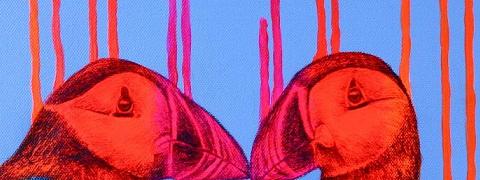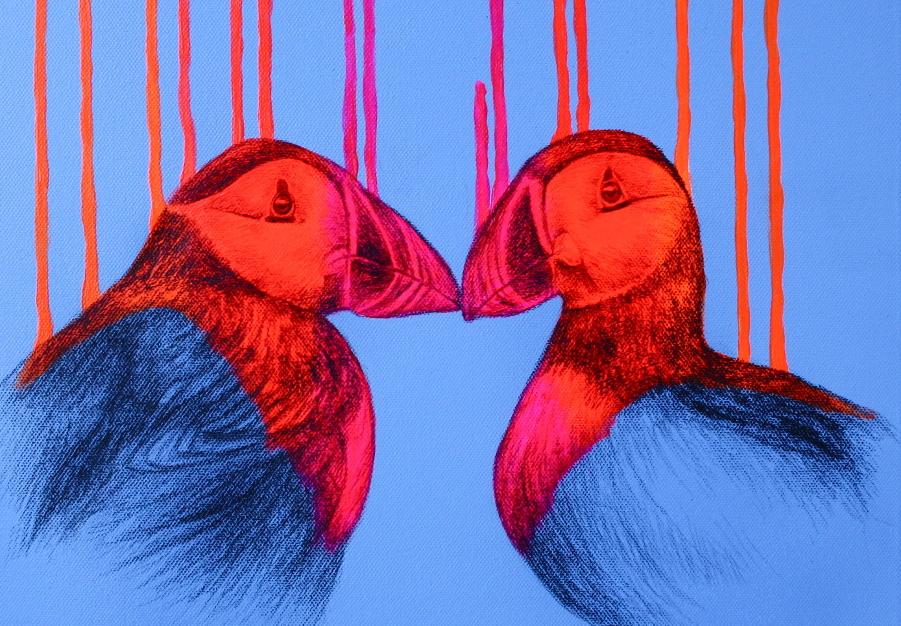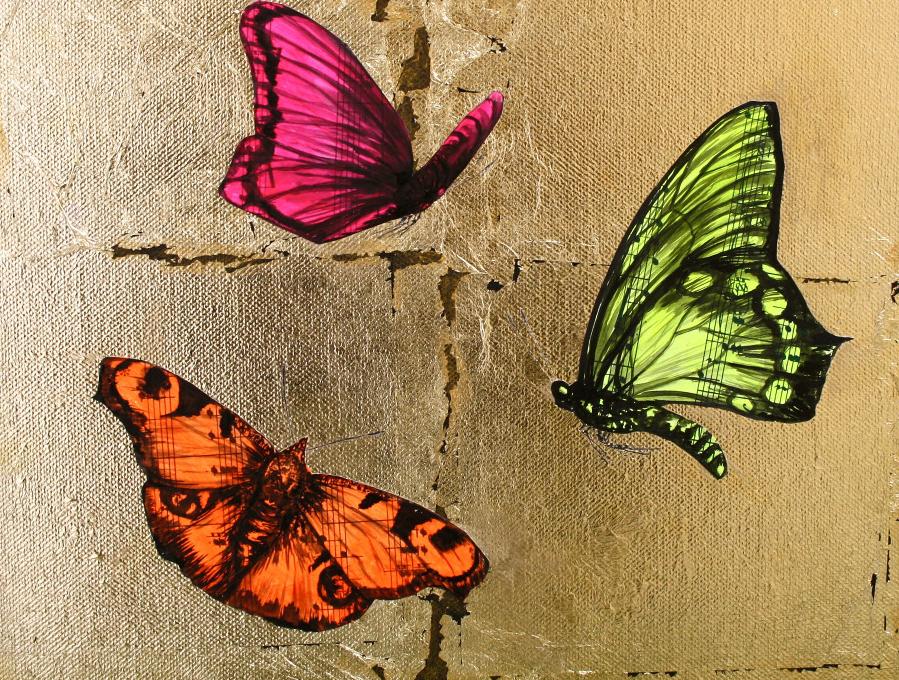[dropcap style=”font-size:100px; color:#992211;”]I[/dropcap]
n East London there is a shrine of deep purple, filled with fluorescent animals.
A stag is lit by the sunbeams of an impossibly orange sunrise, hummingbirds radiate a celestial light as they hover god-like inside the orb of the universe, a supernatural ostrich egg reveals a glowing embryo within, and a moth flutters inside a light bulb.
Like the simple moth and it’s aspirations of reaching incandescence, perhaps these wise animals have also sought and acquired a one-ness with the light.
Straddling the line between haunting illustrations and paintings that entice our perception with their bright designs, these works spring from Louise McNaught, a young emerging artist who graduated only last year from Greenwich University. She has since made impressive developments in her artistic career. Her work takes the viewer’s mind to a magical world where animals are gods, magic exists, and things around us possess an ethereal, delicate yet simultaneously bold appearance.
Chantelle Purcell Interviews Louise McNaught from Degree Art on Vimeo.
In the artist’s eyes, the canvas space has an element of organic ‘aliveness’ which ushers the finished pieces into existance: “I begin with a fairly plain background or support, perhaps of just one colour, this creates an imaginary, numinous space for the creatures to exist…I build the work up in thin layers of paint, so it slowly reveals itself to me as it comes into being.”
There is certainly something divine about McNaught’s work – the paintings themselves are both playful and arresting. She creates pencil drawings of animals as icons, sometimes weaving in celestial elements like star maps, and then renders parts of these delicate images in fluorescent paint, which is left to drip down the surface. But instead of oozing south towards the inevitable base of the canvas, the drips levitate upwards.
In this world, paint is lighter than air and it floats ever onwards in its journey from the aura of these animals to some higher place past the rim of the artwork and our vision.
McNaught’s skillful hand is attracted time and time again to animal imagery, rendering character and detail meticulously. On one level the iconic forms and eye-catching colours would equally sit well in a trendy wardrobe. However upon closer inspection, roaming their purple sanctuary, these artworks are rather bewitching in their own right. As the artist talks about her respect and concern for the environment, a genuine awe of nature is clear in her spirit, and this also passes into the artworks.
It is not the canvases, but the beasts which have been imbued with an otherworldliness. The backgrounds are left raw, or treated in one flat colour, allowing the creatures to exert their presence within the piece. “The animals that occur in my work predominantly have a connection to Celtic mythology,” says McNaught, “…deer, bees, owls, rabbits and butterflies… otherworldly creatures such as hummingbirds making an entrance from time to time”.
Inside this dreamlike microcosm where luminescence hints at a hallowed state, radioactive colours imply a simultaneous darker side. McNaught’s style suggests a delicate relationship between nature and ourselves, making a clear point about man’s habit of destruction. The natural world is where humans originate, yet it flutters jewel-like in the balance. These works try to bring our perception back to nature as the basis of life and the awe-inspiring crux of the world we live in.
[quote]Working on such
a large scale
is much more
physical than I
am used to[/quote]
But what of the fluorescents? The artist explains that she wants to portray the celestial realm through her glorious, blazing neon hues. Animals are made God-like, sublime and ethereal in their luminescence.
What interests me is the many other connotations of neon, both in the art world and beyond, and how these might feed into our reading of the artwork. Perhaps nature is fighting back by becoming contemporary, bringing forth its immense energy and a graceful, majestic power to manifest as a fluorescent aura. But by taking on the optical properties of a deep-sea jellyfish, these creatures also remind us that the neon is not neoteric, fluorescent is not newfangled: nature was there first.
Painting an entire gallery space purple and declaring a shrine-like state is part of the artist’s treatment of the work space for her current residency, where she has been challenging herself mentally and physically with her biggest works yet. “Working on such a large scale is much more physical than I am used to – the canvas was too big for my easel and I got frequent muscle ache in my arms from drawing butterflies up high.”
So where is this purple shrine? Until 28th July this year, it nestles at DegreeArt’s Vyner Street gallery space, ‘The Execution Room’: Hosting unique, ground-breaking exhibitions since 2007, “our residency programme is a natural evolution in further supporting and providing a platform for emerging artists.” says Isobel Beauchamp of DegreeArt.
“The programme so far has transformed the exhibition space into a catalyst for discussion, exchange, development and action. Our hopes for next year are to provide an even more experimental program that will see international exchanges as well as group and solo residencies that challenge the notions of display and presentation and work to provide an educative, accessible archive.”
It is unusual to see an ultimately commercial gallery forming such close, nurturing relationships – and pleasing to see the efforts to give artists the time and space to develop their practice coming to fruition. In the art world we need to see more commercial galleries with such a healthy attitude towards working with artists as creatives, not just producers.
The materiality of fluorescents cannot be captured on camera, so this trip is one best made in person if you get the chance to see McNaught’s work in the flesh. Captured by the serenity of her animals, you will journey somewhere meditative and divine; but then plunge deeper into a pleasant hallucination, as their casual psychedelic overtones glimmer.
Catch Louise’s work at her website
Images courtesy of the artist
Nicola Anthony is a British artist known for her public art around the world. Her text sculptures are made of metal, words, memories and narratives. She has worked internationally with NGOs, art institutions, public spaces and cultural research bodies to create art which tells the stories that are often left unspoken.























